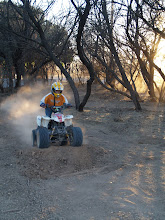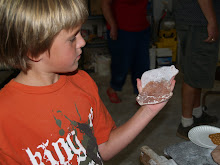Who knew we would be so into nature this first week of vacation... :) It has inspired us to go on little adventures and has also given Todd the itch to get his jeep back together (at my urging...:) ). This morning Hannah and I are going to the Monestary, right down the road, and take pictures of leaves and bugs and birds and what ever else we find. We are having a blast! So check back this evening and there are sure to be new photos of Southeastern Arizona desert life. :)
Have a great day!
Thursday, May 31, 2007
More on the swallows...
We were reading on the mud swallow last night... Hannah was tickled to learn that this pair will more than likely be here next year to have another batch of babies. I was excited to learn that they are monogamous. We go out every morning and talk to the new babies and are wondering how long it takes them before they fly.
More on the Swallows...
Behavior This is what we have to look forward too. : )
This is what we have to look forward too. : )
Barn Swallow chicks waiting to be fedhttp://en.wikipedia.org/wiki/Hirundinidae
Swallows are
excellent
fliers, and use these skills to attract a mate and to defend
territory. In
general, the males select a nest site, and then attract a
female using song and
flight, and guard their territory. The size of the
territory varies depending on
the species of swallow; in colonial-nesting
species it tends to be small, but it
may be much larger for solitary
nesters. The air speed of a fairly typical
unladen European swallow is
estimated to be roughly 24 miles per hour.[1]
Pairs of mated swallows are
monogamous,[2] and pairs of non-migratory species often stay
near their breeding area all year, though the nest site is defended most
vigorously during the breeding season. Migratory species often return to the
same breeding area each year, and may select same nest site if they were
previously successful in that location. First-year breeders generally select a nesting site
close to where they were born and raised.[3]
Most species
hunt over open country or near water.
Swallows are able to produce many
different calls or songs, which are used to express excitement, to
communicate
with others of the same species, during courtship, or as an
alarm when a
predator is in the area. Begging calls are used by the young
when soliciting
food from their parents. The typical song of swallows is a
simple, sometimes
musical twittering.
Wednesday, May 30, 2007
Horny Toad...




From Wikipedia, the free encyclopedia
Horned lizards (Phrynosoma) are a genus of the Phrynosomatidae family of lizards. The horned lizard is popularly called a "horned toad," "horny toad", or "horned frog," but it is neither a toad nor a frog. The popular names come from the lizard's rounded body and blunt snout, which give it a decidedly toad-like or frog-like appearance. (Phrynosoma literally means "toad-bodied.") The spines on the back and sides of this lizard are made from modified scales, whereas the horns on the heads are true horns (i.e. they have a bony core).
Horned lizards (Phrynosoma) are a genus of the Phrynosomatidae family of lizards. The horned lizard is popularly called a "horned toad," "horny toad", or "horned frog," but it is neither a toad nor a frog. The popular names come from the lizard's rounded body and blunt snout, which give it a decidedly toad-like or frog-like appearance. (Phrynosoma literally means "toad-bodied.") The spines on the back and sides of this lizard are made from modified scales, whereas the horns on the heads are true horns (i.e. they have a bony core).
Horned lizards carry with them a wide variety of means to avoid predation. Their coloration generally serves as camouflage. When threatened, a horned lizard's first defense is to remain still and hope it avoids detection. If it is approached too closely and is forced to move, it generally runs in short bursts and stops abruptly, hoping to confuse the predator's visual acuity. If this fails, it will puff up its body to cause its spiny scales to protrude, making it appear larger and more difficult to swallow. At least four species also have the ability to squirt an aimed stream of blood from the corners of the eyes for a distance of up to 3 feet. The horned lizard is able to do this by restricting the blood flow leaving its head, thereby increasing blood pressure and rupturing tiny vessels around the eyelids. This not only confuses would-be predators, but the blood is also foul-tasting to canine and feline predators. It appears to have no effect against predatory birds. But the horned lizard has yet more defenses in its bag of tricks should a predator attempt to pick it up.
Even the dogs wanted to play with the lizzard, toad thingy... :)

Vinnie was very interested and tried to taste him.

Yoda was not too sure about any of it.

Of course Max had to get his nose into all of it and the lizzard scared him.
They both jumped alot.

Hannah tried picking it up by the tail... lets just say we saw how big they can puff up too! :)
5 Little Birdies... 2 more.
Sunday, May 27, 2007
The Dog,the Cat and the Lizzard
The dog did not seem to be bothered by the lizzard...

The cat wanted to eat the lizzard... :)

Help!! A Lizzard...
Saturday, May 26, 2007
Little League
Hannah and the butterfly...
Hannah loves bugs!!
Especially butterflys, and this butterfly landed on Hannah and stayed most of the afternoon. :)




Welcome to Everything Hannah
Welcome to Everything Hannah... This is to keep all of our loved ones close to Hannah's world. :) We hope you come and visit often (I promise to try and keep current...:) )
Subscribe to:
Comments (Atom)


















